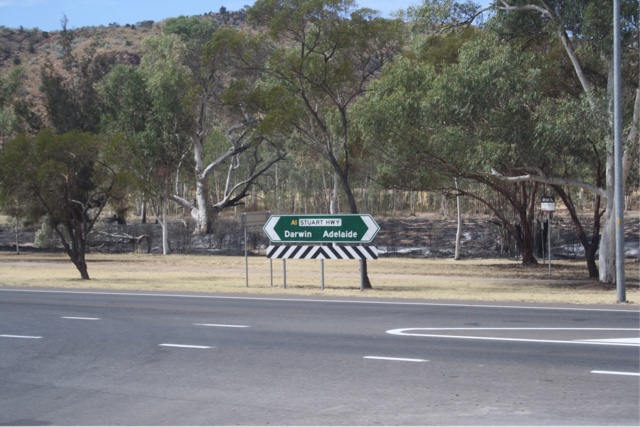Our next destination on our stopover in Alice Springs was the Old Telegraph Station. This place has a lot of history.
This complex, 4 km north of the Alice Spring town centre was declared a heritage site in 2004. This was just one of 12 repeater stations along what was known as the Overland Telegraph Line, which when completed in 1872, stretched from near Adelaide to Palmerston as Darwin was known then. This line was connected to an undersea communications cable which ran from Europe to Java, to the north of Australia. ( Java is actually closer to Darwin than Sydney, so that northern town was an obvious choice) When the line was completed and linked to the undersea cable , instead of messages taking 40 days to travel from London to Australia, they now only took 24 hours. Eventually other Australian colonies were linked by telegraph line.
So this station at Alice was the first white settlement in this part of central Australia. It closed in 1932 when a new Post office was built and the precinct was later used as a residence and educational institution for part Aboriginal children until 1942, when it was taken over by the army during WW2. After the war it was returned to the Aboriginal Affairs department until 1963 when it became a historical reserve.
What lovely old stone buildings...
On our tour we had Georgia as our guide...she had only been a guide for 3 weeks...but she was good!
So then the wooden posts were replaced by metal poles like this one outside the old post office
There were exhibits to look at...the 'tyres' on the homemade handcart were made with pieces of cork! Ingenious way of making do with what was to hand.
The town of Alice Springs is on the Todd River...but all is not how that sounds. The Todd River rarely has any water flowing...it's just a sandy river bed. It is described as an 'ephemeral river' on this website here.
And in typical Aussie larrikin spirit, Alice Springs has the annual Henley on Todd Regatta (since 1961) in which people race bottomless vessels by carrying/running them on the course on the dry river bed! Apparently the organisers take out insurance in case the river does flow when the regatta is due.
This complex, 4 km north of the Alice Spring town centre was declared a heritage site in 2004. This was just one of 12 repeater stations along what was known as the Overland Telegraph Line, which when completed in 1872, stretched from near Adelaide to Palmerston as Darwin was known then. This line was connected to an undersea communications cable which ran from Europe to Java, to the north of Australia. ( Java is actually closer to Darwin than Sydney, so that northern town was an obvious choice) When the line was completed and linked to the undersea cable , instead of messages taking 40 days to travel from London to Australia, they now only took 24 hours. Eventually other Australian colonies were linked by telegraph line.
So this station at Alice was the first white settlement in this part of central Australia. It closed in 1932 when a new Post office was built and the precinct was later used as a residence and educational institution for part Aboriginal children until 1942, when it was taken over by the army during WW2. After the war it was returned to the Aboriginal Affairs department until 1963 when it became a historical reserve.
What lovely old stone buildings...
On our tour we had Georgia as our guide...she had only been a guide for 3 weeks...but she was good!
She has the same fascination with John McDouall Stuart's achievements in exploration of this part of Australia that I have had from my school days. And everyone in the group listened attentively as we had a very informative talk from Georgia...then it was time to explore further.
 |
| This is an example of the posts that were originally used for the telegraph posts carrying the wire...unfortunately the termites kept destroying the posts . |
There were exhibits to look at...the 'tyres' on the homemade handcart were made with pieces of cork! Ingenious way of making do with what was to hand.
 |
| Georgia explained that this tree was already growing here when the station was built 1871-72 |
And in typical Aussie larrikin spirit, Alice Springs has the annual Henley on Todd Regatta (since 1961) in which people race bottomless vessels by carrying/running them on the course on the dry river bed! Apparently the organisers take out insurance in case the river does flow when the regatta is due.























































